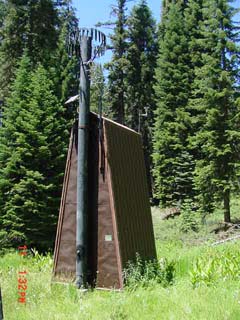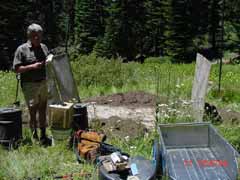Sierra
Nature Notes, Volume 2, February 2002
Monitoring
Snow from the Beach in San Diego:
Automatic Snow Sensors in the Sierra
Jessica Lundquist
Ph.D. Candidate
Hydroclimatology Group
Scripps Institution of Oceanography
University of California, San Diego
Remote Sensors
in the Sierra
"So what do you study at Scripps Institution of Oceanography?" people
always ask when they meet me, expecting to hear great stories about whales
and dolphins. "I study snowmelt in the Sierra Nevada Mountains,"
I reply. "I'm the high altitude oceanographer!" In an era of automatic
sensors, computers, and high-speed communications, being an armchair scientist,
studying snow from the beach, is easy. Or is it?
 |
|
DWR Snow
Survey: The water content of the snowpack is the difference between
the weight of empty tube and that of the tube and snow core. |
Most Sierra snow measurements are conducted by the California Department of Water Resources (CDWR) Cooperative Snow Survey Department, which has been formally monitoring winter snow conditions since 1930, longer than any other such program in the Western United States. In a tradition dating back to when the survey began, snow depth and water content are calculated once a month during the winter season at over 300 snow courses across the state. Working in pairs, surveyors cross-country ski to each snow course, marked by bright orange signs on trees, and plunge a hollow aluminum tube deep into the snowpack until they hit ground level. From this they calculate the snow depth. After removing any dirt from the tube's end, they weigh the tube, now filled with snow. Because we know how much a cubic centimeter of water weighs, this allows the surveyors to calculate the liquid water content of the snow. When all the snow courses are sampled, forecasters can calculate how much water will be available to cities and agriculture in the upcoming spring and summer.
Manual snow surveys
are still conducted monthly during the winter, but in 1974 the snow survey
realized that a lot can happen to the snowpack in a month. Huge snowstorms
can cause rapid snow accumulation and extreme avalanche danger; a warm rain
can quickly melt the existing snowpack bringing severe flooding to the lowlands.
To capture daily and hourly variations in the snowpack and mountain weather,
the CDWR now operates over 100 automatic snow stations, which send data via
satellite to a central processing station in Sacramento. Snow information
is updated daily at http://cdec.water.ca.gov/snow/,
so that anyone can keep track of the Sierra snowpack.
Get More Data
When I began my project studying when and where snow melts to feed the spring
runoff in Yosemite National Park, I found the online snow sensor data immensely
valuable. My only complaint was "Why isn't there more of it?" When
I asked the Chief Snow Surveyor, Frank Gehrke, for more sensors at higher
altitudes, he offered me the opportunity to help and find out just how much
work each one of those sensors requires. Repairing and installing automatic
snow sensors takes as much work in the summer as the snow surveys on skis
require in the winter. (At least it makes for a year-round job!)
I began my summer adventures by loading an old white work truck with 12 large army drums filled with a mixture of ethyl alcohol and propylene glycol, an antifreeze solution. The stuff looks clear and feels slippery. "Don't worry," Frank told me as I sloshed the liquid over my arms while trying to move a container too heavy for me. "This is the same stuff you find in hand-lotion. It's good for your skin." It's also better for the environment than the toxic ethylene-glycol-based antifreeze, similar to the green-colored stuff you pour in your car, used previously. Only 3 to 4 tablespoons of the old antifreeze can kill a medium-sized dog. After the antifreeze, we loaded four large, square, stainless-steel plates, 4 feet to a side and about 2 inches thick, followed by a host of stainless steel pipes and plumbing supplies, a pair of shovels and a rake, and a metal, fold-up cart. As we drove for a day and a half from Sacramento to the small town of Quaking Aspen in the southern Sierra, Frank explained to me that the CDWR Snow Survey is unique in that it is funded and directed by the very people who use it most: water districts and farmers of the Central Valley, who depend on runoff from the snowpack to fill their reservoirs and water their crops. The instrumentation at each automatic snow station is decided on and paid for by the people directly downstream, based on the information they think will most improve their spring water forecast.
 |
| Shelter and precipitation gauge at Quaking Aspen. The solar panel is to the left of the precipitation gauge, and the temperature sensor is to the right. |
Quaking Aspen is a typical automatic snow station, situated in a small, flat meadow carpeted with wildflowers and fringed with pine trees at an elevation of 7,200 ft. The meadow site allows snow to accumulate without being impeded by vegetation, while the fringing trees provide shelter from strong winds. Additionally, the site, like most, was located about 500 meters from any road. This serves the purpose of keeping unwanted visitors from finding and possibly vandalizing the site but also requires field technicians to transport all field equipment. In our case this was 50 gallons of antifreeze, 4 snow pillows, and several cartons of plumbing supplies all hauled to the site by hand, horse, wheelbarrow, or cart. After numerous trips up and down a steep slope and several dents to our fold-up cart, our first order of business was to dig up the old snow pillow, which was buried one foot beneath a thick tangle of plants. Digging down one foot is easy, but with four metal pillows, each four feet to a side, we had to remove 256 cubic feet of dirt, a process I soon found to be no small task!
 |
| Frank, surrounded by drums of antifreeze, stands in front of the recently excavated snow pillows at Quaking Aspen. |
As we unearthed the old snow pillows and replaced them with the new ones, I learned how a snow pillow works. The four pillows are filled with antifreeze and connected with pipes to each other and then to a reservoir of antifreeze inside of a small wooden shelter, where the instruments for data collection and telemetry are housed. When snow falls on the pillow, its weight forces antifreeze through the pipes and causes the reservoir to rise higher in a tube, which is calibrated to show how much water weight causes a certain water-level rise. A float connected by a string through a pulley system floats on the top of the reservoir. As the reservoir rises, so does the float, and the pulley system turns a wheel at the top of the apparatus. This turning of the wheel is recorded as a digital click, which is then relayed via satellite to the central processing station, which adds or subtracts an increment of water weight, or snow water equivalent, depending on which direction the wheel turned. The resolution of most pillows is 0.1" of water.
We carefully drained the toxic fluid out of the old pillows then set the new ones in place, filled them with the harmless antifreeze, and hooked them to each other and the main hydraulic line. After reburying the new pillows, we were careful to record the height of the reservoir as the baseline for no snow. We also checked the precipitation gauge, which operates on the same principles; the temperature sensor; the solar panels and battery that power the system; and the satellite transmitter.
Covered with dirt and mosquito bites, but proud of our handiwork, we headed back to the truck in the twilight, only to notice scratches from a bear on a nearby tree. "Uh oh," muttered Frank, "we forgot the bear armor." Sierra black bears are very curious about snow pillows and have a tendency to "investigate" them until they spring a leak. To prevent the pillows from being torn to shreds, the snow survey team puts steel casings that look like a chain mail jacket around the pillows that a bear can't get through. "But we buried it!" I whined, afraid that I was going to have to start digging again. "Well," Frank replied, "I don't have the armor with me, so we can hope this bear's not a digger. If he is, we get to do this again next summer."
As we hauled
the last of the old pillows' antifreeze (this was the toxic stuff) up to the
truck, taking care not to dump the cart as we negotiated tree roots and berry
bushes, I started to think twice about all those stations I wanted in remote,
high-altitude locations. "Don't we have anything more lightweight and
compact to measure the snow?" I whined yet again. "I'm glad you
asked," Frank replied. "I have another job for you."
Continued
Our Founder Questions? Go to About Our New Site |
Masthead
Photo from: |